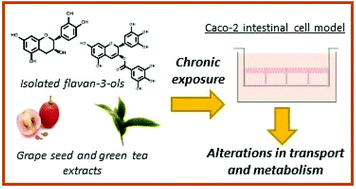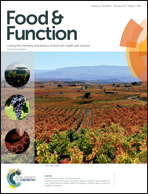Differentiated Caco-2 cell monolayers exhibit adaptation in the transport and metabolism of flavan-3-ols with chronic exposure to both isolated flavan-3-ols and enriched extracts†
Abstract
The relatively low oral bioavailability of flavan-3-ols from acute doses is commonly highlighted as a limitation when considering the biological significance of these compounds. However, evidence suggests that the absorption of flavan-3-ols may be enhanced during periods of repeated exposure which is more representative of dietary patterns. To explore changes occurring in the upper small intestine from repeated exposure to dietary flavan-3-ols, Caco-2 human intestinal cells were cultured and differentiated in the presence of isolated flavan-3-ols epigallocatechin gallate (EGCG) and epicatechin (EC) or flavan-3-ol-rich green tea and grape seed extracts. Following differentiation, cellular accumulation, Phase II metabolism, and transcellular transport were assessed from a final acute dose of the respective pretreated compound or extract. 10 μM EGCG pretreatment significantly (P < 0.05) decreased the appearance rate of both sulfated and methyl sulfate EGCG metabolites compared to the control. In contrast, 10 μM EC pretreatment resulted in a significantly greater appearance of methylated EC from acute treatment. After 4 h, 10 μM green tea extract pretreatment resulted in a significant (P < 0.05) 38% greater cumulative transport of EC, in addition to 44–60% increased transport of EGCG and epicatechin gallate (ECG) at 60 min compared to the control. For monolayers pretreated with 10 μM grape seed extract, there was a significant (P < 0.05) 17–56% greater cumulative transport of C and EC after 4 h. Assessment of the mRNA expression of select xenobiotic and metabolizing genes revealed that pretreatment with green tea and grape seed extracts significantly (P < 0.05) increased the expression of COMT, ABCC2 and ABCB1. Overall, these results suggest that intestinal adaptation to both isolated flavan-3-ols and extracts rich in these compounds alters their intestinal transport and metabolism.


 Please wait while we load your content...
Please wait while we load your content...